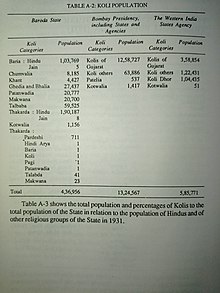| Talpada Koli તળપદા કોળી | |
|---|---|
| Sub-caste of the Koli caste | |
 Koli population in Gujarat in 1931 including Talpada Kolis | |
| Ethnicity | Koli people |
| Location | |
| Varna | |
| Parent tribe | Kolis of Gujarat |
| Population | 59,525 (1931) |
| Demonym(s) | |
| Branches |
|
| Language |
|
| Religion | |
| Surnames | |
The Talapada Koli,[1] or Talpada Koli,[2] is a subcaste of the Koli caste of Gujarat state in India.[3] Talapada Kolis are agriculturists by profession.[4] they were members of the Gujarat Kshatriya Sabha, an organisation launched by Natwarsinh Solanki who was a Koli elite.[5] In 1907, they were classified by the British as a Criminal Tribe, ascribing to them a range of anti-social activities such as highway robbery, murder, and theft of animals, cattle and standing crops. They were also alleged to be blackmailers and hired assassins.[6]
The Talpada Kolis used the title of Kotwal because of their high position villages and served to rulers as Kotwal and they were granted the villages or large field and title of Pagi because they were good detective for rulers or any chief.[7] Another title of Talapada Kolis is Patel because they are agriculturists and respected cultivators from old days.[8]
- ^ Patel, Mahendra Lal (1997). Awareness in Weaker Section: Perspective Development and Prospects. New Delhi, India: M.D. Publications Pvt. Ltd. p. 251. ISBN 978-81-7533-029-0.
- ^ "Gujarat: Rs 5 lakh fine for provocative social media messages | Rajkot News - Times of India". The Times of India. TNN. Jan 29, 2021. Retrieved 2022-03-27.
- ^ Shah, A. M. (1998). The Family in India: Critical Essays. New Delhi, India: Orient Blackswan. pp. 126–128. ISBN 978-81-250-1306-8.
- ^ Chahel, Paramjot Singh (2015-10-30). Undisclosed Facts of Tribal Life. New Delhi, India: Partridge Publishing. ISBN 978-1-4828-3834-3.
- ^ Lal, R. B. (2003). Gujarat History. New Delhi, India: Popular Prakashan. pp. 716–721. ISBN 978-81-7991-104-4.
- ^ Yagnik, Achyut (2005-08-24). Shaping Of Modern Gujarat. New Delhi, India: Penguin UK. ISBN 978-81-8475-185-7.
- ^ Shah, A. M. (2002). Exploring India's Rural Past: A Gujarat Village in the Early Nineteenth Century. New Delhi, India, Asia: Oxford University Press. pp. 82–91. ISBN 978-0-19-565732-6.
- ^ Tambs-Lyche, Harald (1996-12-31). Power, Profit, and Poetry: Traditional Society in Kathiawar, Western India. New Delhi, India: Manohar Publishers & Distributors. pp. 131: Tarabda. ISBN 978-81-7304-176-1.